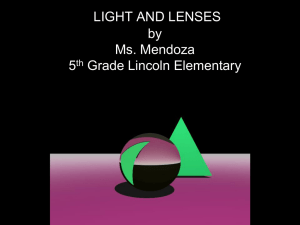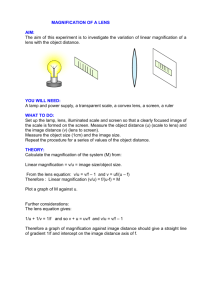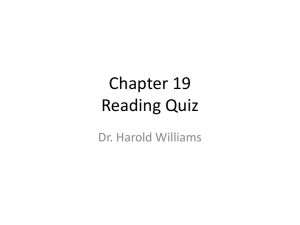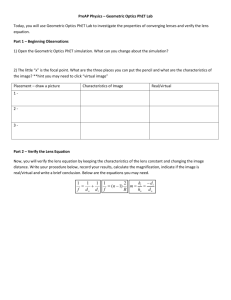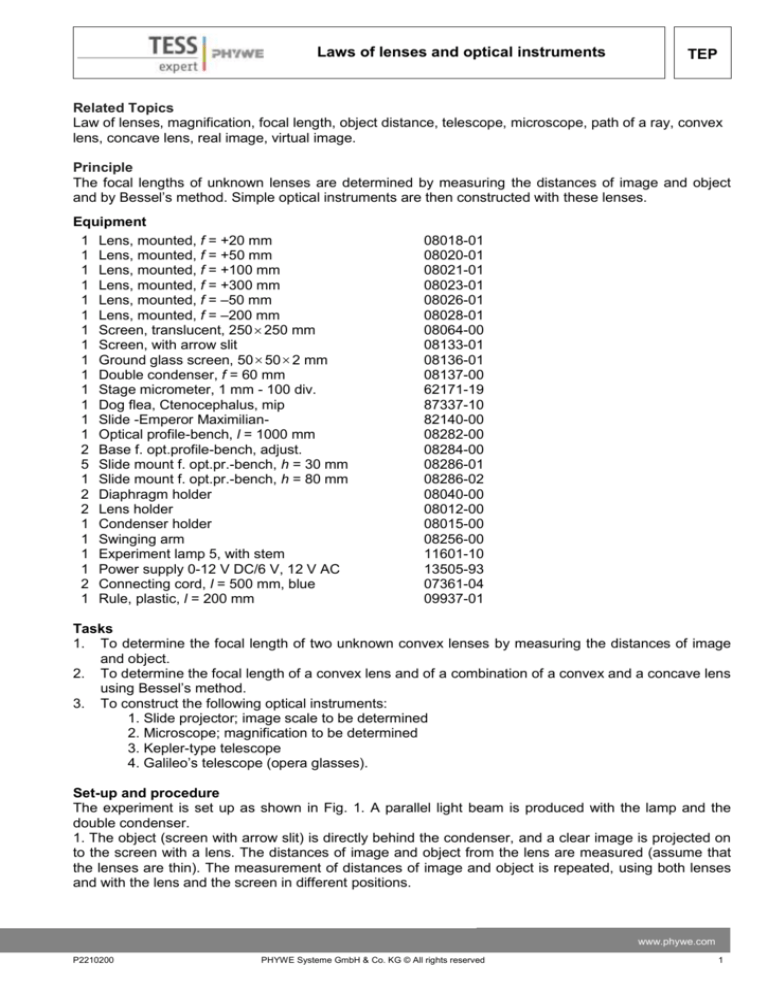
Laws of lenses and optical instruments
TEP
Related Topics
Law of lenses, magnification, focal length, object distance, telescope, microscope, path of a ray, convex
lens, concave lens, real image, virtual image.
Principle
The focal lengths of unknown lenses are determined by measuring the distances of image and object
and by Bessel’s method. Simple optical instruments are then constructed with these lenses.
Equipment
1 Lens, mounted, f = +20 mm
1 Lens, mounted, f = +50 mm
1 Lens, mounted, f = +100 mm
1 Lens, mounted, f = +300 mm
1 Lens, mounted, f = –50 mm
1 Lens, mounted, f = –200 mm
1 Screen, translucent, 250 250 mm
1 Screen, with arrow slit
1 Ground glass screen, 50 50 2 mm
1 Double condenser, f = 60 mm
1 Stage micrometer, 1 mm - 100 div.
1 Dog flea, Ctenocephalus, mip
1 Slide -Emperor Maximilian1 Optical profile-bench, l = 1000 mm
2 Base f. opt.profile-bench, adjust.
5 Slide mount f. opt.pr.-bench, h = 30 mm
1 Slide mount f. opt.pr.-bench, h = 80 mm
2 Diaphragm holder
2 Lens holder
1 Condenser holder
1 Swinging arm
1 Experiment lamp 5, with stem
1 Power supply 0-12 V DC/6 V, 12 V AC
2 Connecting cord, l = 500 mm, blue
1 Rule, plastic, l = 200 mm
08018-01
08020-01
08021-01
08023-01
08026-01
08028-01
08064-00
08133-01
08136-01
08137-00
62171-19
87337-10
82140-00
08282-00
08284-00
08286-01
08286-02
08040-00
08012-00
08015-00
08256-00
11601-10
13505-93
07361-04
09937-01
Tasks
1. To determine the focal length of two unknown convex lenses by measuring the distances of image
and object.
2. To determine the focal length of a convex lens and of a combination of a convex and a concave lens
using Bessel’s method.
3. To construct the following optical instruments:
1. Slide projector; image scale to be determined
2. Microscope; magnification to be determined
3. Kepler-type telescope
4. Galileo’s telescope (opera glasses).
Set-up and procedure
The experiment is set up as shown in Fig. 1. A parallel light beam is produced with the lamp and the
double condenser.
1. The object (screen with arrow slit) is directly behind the condenser, and a clear image is projected on
to the screen with a lens. The distances of image and object from the lens are measured (assume that
the lenses are thin). The measurement of distances of image and object is repeated, using both lenses
and with the lens and the screen in different positions.
www.phywe.com
P2210200
PHYWE Systeme GmbH & Co. KG © All rights reserved
1
TEP
Laws of lenses and optical instruments
Fig. 1: Experimental set-up (microscope).
2. If, at a fixed distance d between object and image (case I), we alter the position of the lens so that the
image and object distances are transposed (case II), we still obtain a clear image of the object. In case I
the image is magnified, in case II it is reduced (Fig. 2).
Fig. 2: Determination of focal length after Bessel.
Using a convex lens of focal length +100 mm, for instance, measure the distance e at which a sharp image is obtained for both possible lens positions (repeat the measurement and calculate the average value e . Now take a measurement in the same way but using the convex lens from the first measurement
and a concave lens (-200 mm for example). Make the distance d as large as possible, and measure at
least four times the combined focal length.
3.1. Slide projector
Place the slide – Emperor Maximilian – immediately behind the condenser and project an image on the
screen with the lens L2 ( f 2 = +100 mm).
2
PHYWE SYSTEME GMBH & Co. KG © All rights reserved
P2210200
Laws of lenses and optical instruments
TEP
To obtain the best image illumination set the condenser so that the image of the lamp coil is in the plane
of objective lens L2 (Fig. 3).
Determine the magnification M of the image
M
B
G
Fig. 3: Path of a ray in a slide projector.
3.2 Microscope
A magnified image of a small object (stage micrometer and micro-slide of a dog flea) is produced with a
lens L1 of short focal length f1 = +20 mm. The real intermediate image is observed through an eyepiece
L2 ( f 2 = +50 mm) (Fig. 4). The ground glass and the object holder with the object are fixed in the
swinging arm. L1 is brought as close to the object as possible. The object is illuminated through a
ground glass screen.
The size of the image and thence the overall magnification are roughly determined by comparing it with a
scale at the least distance of distinct vision (approximately 25 cm). To do this we look through the microscope with the right eye and at the scale with the left. With practice the two images can be superimposed.
Fig. 4: Path of a ray in the microscope.
www.phywe.com
P2210200
PHYWE Systeme GmbH & Co. KG © All rights reserved
3
TEP
Laws of lenses and optical instruments
3.3 Telescope after Kepler
A convex lens of long focal length f1 (+300 mm, for example), and one of short focal length f 2 (e.g. +50
mm) are secured to the optical bench at a distance of f1 + f 2 (Fig. 5).
Fig. 5: Path of a ray in a Kepler telescope.
If we look through the lens of short focal length, we can see an inverted, magnified image of a distant object.
3.4 Galileo telescope (opera glasses)
A convex lens of long focal length f1 (+300 mm, for example) and a concave lens of short focal length
f 2 (e. g. -50 mm) are set up at a distance of f1 – | f 2 | (Fig. 6).
Through the concave lens we can see distant object magnified and the right way up.
Fig. 6: Path of a ray in Galileo telescope.
Theory and evaluation
The relationship between the focal length f of a lens, the object distance g and the image distance b is
obtained from geometrical optics. Three particular rays, the focal ray, the parallel ray and the central ray,
are used to construct the image (Fig. 7).
Fig. 7: Image construction with three principal rays.
4
PHYWE SYSTEME GMBH & Co. KG © All rights reserved
P2210200
Laws of lenses and optical instruments
TEP
From the laws of similar triangles,
B b
G
f
and
G g
B b f
where B is the image size and G is the object size.
By transforming we obtain the lens formula
b g
1 1 1
or f
bg
f b g
1. From the values of b and g measured in Task 1 we calculate f, the average value of f and its standard
deviation. For the first lens (100 mm) f1 was 100.2 mm with a standard deviation s f1 of 0.6 mm; for the
second (50 mm), f 2 was 53.1 mm with a standard deviation s f 2 of 0.9 mm. (The focal lengths marked
on the lenses have a tolerance of 5%.)
2. Since g I bII (the object distance in case I = image distance in case II) and since g I bII ,
g I bI d
g I bI e
(see
Fig. 2).
If we solve the equations for g I and bI we obtain
gI
1
( d e)
2
b1
1
( d e)
2
Substituting into the lens formula gives
f
d 2 e2
4d
The focal length of the convex lens can therefore be determined
from the measured values of d and e.
If we now use a lens system of focal length f comb . Consisting of the convex lens already measured (focal
length f s ) and a concave lens, and carry out the measurement in the same way, we obtain the following
for the focal length of the concave lens f z :
f
f
1
1
1
or f z comb s
fz
f comb f s
f s f comb
www.phywe.com
P2210200
PHYWE Systeme GmbH & Co. KG © All rights reserved
5
Laws of lenses and optical instruments
TEP
Here we assume that
1
1
fs
fz
as otherwise no real images would be produced. f 2 was 99.7 mm for the convex lens (+100 mm), f comb .
was 180 mm for the combination of two lenses (+100 mm/-200 mm) so that f z = -223 mm represents
the focal length of the concave lens. (The combination of two lenses involves a systematic error as the
distance between the principal planes is disregarded).
3.1 The magnification M is obtained from the relationship between object size and image size b
M
B b f
G
f
When the image distance b is 700 mm and the focal length f =100 mm, then M = 6.
3.2 The overall magnification is obtained by multiplying the magnification due to the objective (Fig. 4),
ßobjective
Y ' a' a'
1
Y
g
f1
by the angular magnification of the eyepiece
L
250mm
f2
With the lenses used we obtain an overall magnification M = 60.
3.3 The objective L 1 provides a real, inverted image of size Y’ 1 of a very distant object, and this image is
observed through the eyepiece L 2 . The angular magnification (for small angles) is
L
' Y '1 / f 2 f1
Y '1 / f1 f 2
3.4 A concave lens is placed in the path of the ray in front of the real first image produced by objective
L 1 so that the focal points F1 and F2 coincide. The eye then sees a virtual, upright image. The magnification is once again
L
f1
f2
Note
You may wish to cover the markings on the lenses used to measure focal length by means of opaque
adhesive tape while performing the experiment, and reveal these values only when the evaluation is finished.
6
PHYWE SYSTEME GMBH & Co. KG © All rights reserved
P2210200


